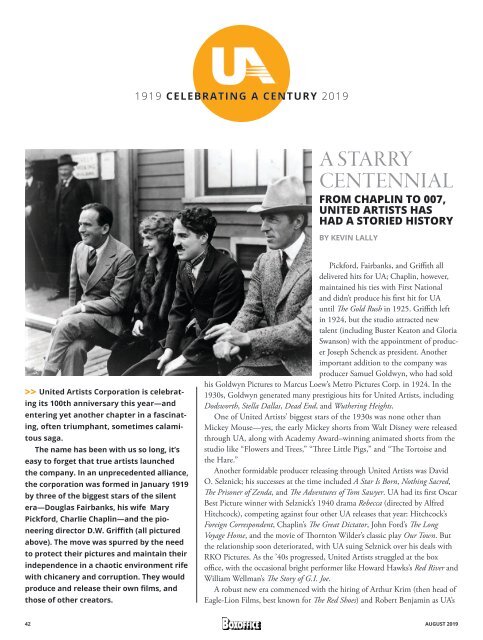Boxoffice - August 2019
The Official Magazine of the National Association of Theatre Owners
The Official Magazine of the National Association of Theatre Owners
Create successful ePaper yourself
Turn your PDF publications into a flip-book with our unique Google optimized e-Paper software.
1919 CELEBRATING A CENTURY <strong>2019</strong><br />
A STARRY<br />
CENTENNIAL<br />
FROM CHAPLIN TO 007,<br />
UNITED ARTISTS HAS<br />
HAD A STORIED HISTORY<br />
BY KEVIN LALLY<br />
>> United Artists Corporation is celebrating<br />
its 100th anniversary this year—and<br />
entering yet another chapter in a fascinating,<br />
often triumphant, sometimes calamitous<br />
saga.<br />
The name has been with us so long, it’s<br />
easy to forget that true artists launched<br />
the company. In an unprecedented alliance,<br />
the corporation was formed in January 1919<br />
by three of the biggest stars of the silent<br />
era—Douglas Fairbanks, his wife Mary<br />
Pickford, Charlie Chaplin—and the pioneering<br />
director D.W. Griffith (all pictured<br />
above). The move was spurred by the need<br />
to protect their pictures and maintain their<br />
independence in a chaotic environment rife<br />
with chicanery and corruption. They would<br />
produce and release their own films, and<br />
those of other creators.<br />
Pickford, Fairbanks, and Griffith all<br />
delivered hits for UA; Chaplin, however,<br />
maintained his ties with First National<br />
and didn’t produce his first hit for UA<br />
until The Gold Rush in 1925. Griffith left<br />
in 1924, but the studio attracted new<br />
talent (including Buster Keaton and Gloria<br />
Swanson) with the appointment of producer<br />
Joseph Schenck as president. Another<br />
important addition to the company was<br />
producer Samuel Goldwyn, who had sold<br />
his Goldwyn Pictures to Marcus Loew’s Metro Pictures Corp. in 1924. In the<br />
1930s, Goldwyn generated many prestigious hits for United Artists, including<br />
Dodsworth, Stella Dallas, Dead End, and Wuthering Heights.<br />
One of United Artists’ biggest stars of the 1930s was none other than<br />
Mickey Mouse—yes, the early Mickey shorts from Walt Disney were released<br />
through UA, along with Academy Award–winning animated shorts from the<br />
studio like “Flowers and Trees,” “Three Little Pigs,” and “The Tortoise and<br />
the Hare.”<br />
Another formidable producer releasing through United Artists was David<br />
O. Selznick; his successes at the time included A Star Is Born, Nothing Sacred,<br />
The Prisoner of Zenda, and The Adventures of Tom Sawyer. UA had its first Oscar<br />
Best Picture winner with Selznick’s 1940 drama Rebecca (directed by Alfred<br />
Hitchcock), competing against four other UA releases that year: Hitchcock’s<br />
Foreign Correspondent, Chaplin’s The Great Dictator, John Ford’s The Long<br />
Voyage Home, and the movie of Thornton Wilder’s classic play Our Town. But<br />
the relationship soon deteriorated, with UA suing Selznick over his deals with<br />
RKO Pictures. As the ’40s progressed, United Artists struggled at the box<br />
office, with the occasional bright performer like Howard Hawks’s Red River and<br />
William Wellman’s The Story of G.I. Joe.<br />
A robust new era commenced with the hiring of Arthur Krim (then head of<br />
Eagle-Lion Films, best known for The Red Shoes) and Robert Benjamin as UA’s<br />
42 AUGUST <strong>2019</strong>

















